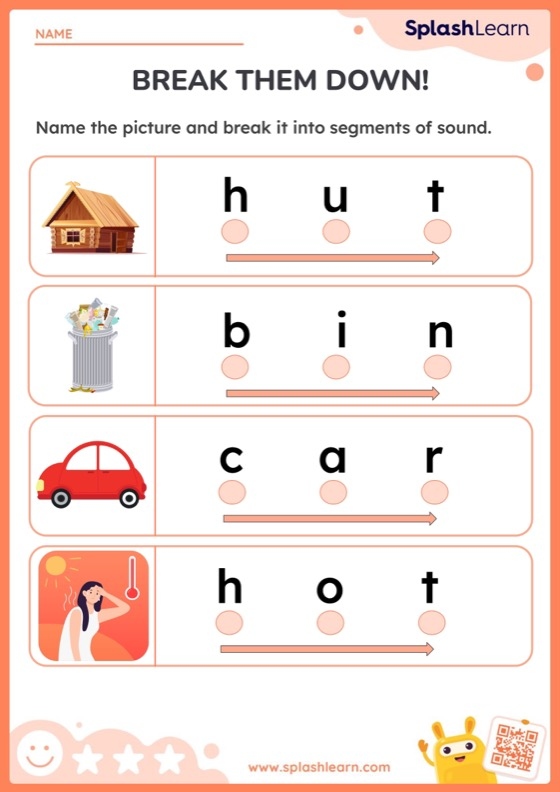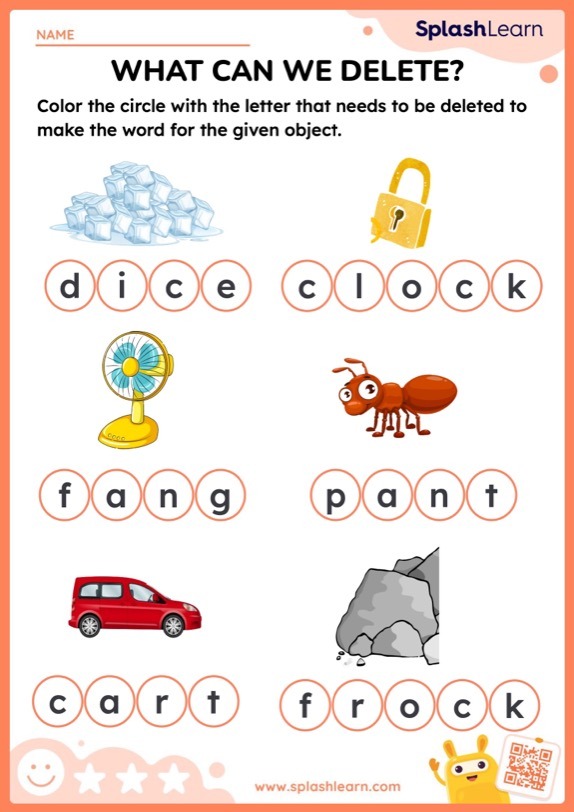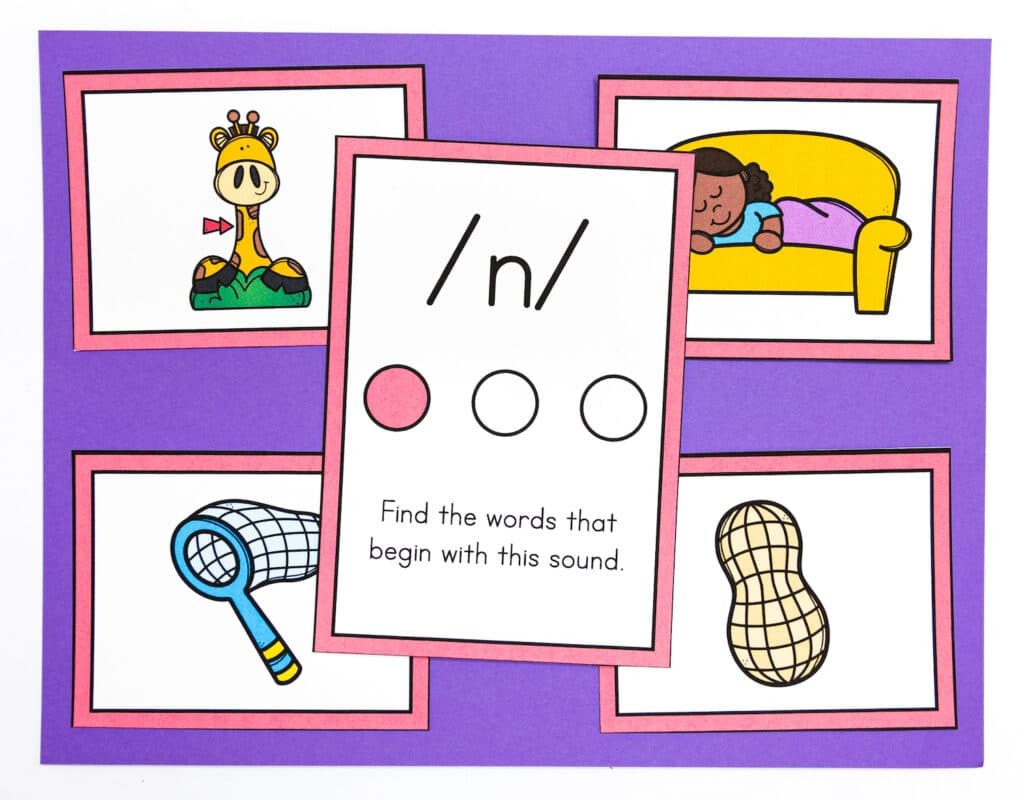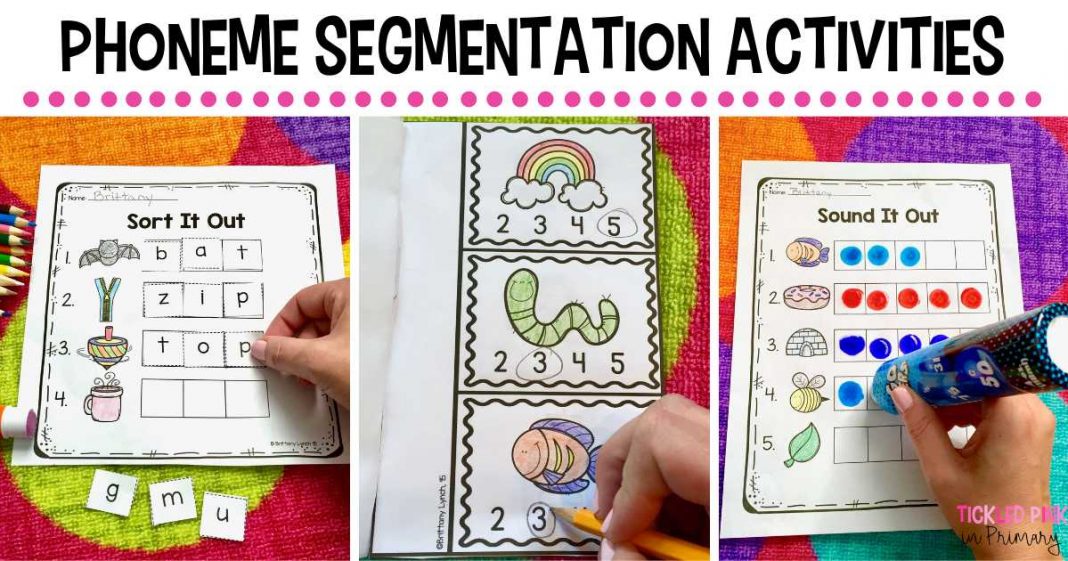Phoneme segmentation activities for kids are a fantastic way to help young learners break down words into individual sounds. This skill is essential for early reading and spelling success. By using fun and interactive activities, children can enjoy learning while building their phonemic awareness. Let’s dive in!
Math & ELA | PreK To Grade 5
Kids see fun.
You see real learning outcomes.
Watch your kids fall in love with math & reading through our scientifically designed curriculum.
Parents, try for free Teachers, use for free
1. Picture Sound Break Down

In this activity, the child will look at each picture, say the word it represents, and then break the word into its sounds or “phonemes.” For example, for the picture of a hut, the child will say “h-u-t” and identify each sound. The child will place a marker under each letter representing a word’s sound.
This activity helps the child become more aware of how words are made up of separate sounds, an important skill for learning to read and spell. It also makes learning fun by connecting the sounds to pictures they recognize.
2. Syllable Splitting Fun
Begin here
The child will see a word in these games and learn how to break it into syllables or sound segments. For example, with the word “fern,” the child will identify and separate it into the sounds “f,” “er,” and “n.” This activity helps children understand that words can be divided into smaller parts, making reading and spelling longer words easier.
By playing this game, kids practice phoneme segmentation in a playful and interactive way, reinforcing their understanding of how words are constructed from different sounds.
3. Sound Deletion

In this activity, the child will look at each picture and then examine the word below it. Their task is to figure out which letter (sound) needs to be deleted from the word to match the picture. For example, for the picture of ice, the child would recognize that the word “dice” has an extra “d” sound at the beginning, so they would color in the circle under the “d” to show it should be removed.
This is one of the best word segmentation activities that helps children understand how removing a sound from a word changes its meaning, reinforcing their phonemic awareness and improving their ability to manipulate sounds within words. It’s a fun way to challenge their growing reading and spelling skills!
Related Reading: How to Teach Letter Sound
4. Picture and Sound Matching Game
Begin here
In this fun matching activity, children will look at pictures and match them to the correct letter or word. First, they’ll find the letter that matches the beginning sound of each picture. Then, they’ll match pictures to their corresponding words.
This activity helps kids connect sounds to letters and words, building their early reading skills. By practicing this, they learn to identify letters’ sounds, which is a key step in learning to read and spell. It’s a simple yet effective way to boost their phonemic awareness!
5. Phoneme Puzzles
Phoneme puzzles are one of the best segmentation activities for kindergarten. Make puzzles where each piece represents a phoneme. Kids can assemble the pieces to form a word, saying each sound as they put the pieces together. This hands-on activity makes learning phoneme segmentation enjoyable and interactive.
6. Clapping Sounds
Clapping sounds is a simple and effective activity for phoneme segmentation. Say a word and have kids clap their hands for each phoneme they hear. This helps them break down the word into individual sounds. Clapping sounds is one of the easiest segmentation activities for kindergarten and is perfect for helping kids develop their phonemic awareness.
7. Sound Counting with Beads
Sound counting with beads is a simple and fun way to practice phoneme segmentation activities. Give each child a string and some beads. Say a word and have them move a bead for each phoneme they hear. This hands-on activity helps kids visually and physically understand how words are broken down into individual sounds, making it one of the effective sound segmentation activities.
8. Phoneme Sorting

Phoneme sorting is a great activity for developing phonemic awareness. Use picture cards and have kids sort them based on the number of phonemes in the word. This activity helps children recognize different phonemes and is one of the practical phoneme segmentation activities for improving their skills. Phoneme sorting can be easily adapted for different levels, making it perfect for various age groups.
9. Phoneme Fishing
Phoneme fishing is a creative way to engage kids in sound segmentation activities. Create a fishing game with paper fish, each marked with a phoneme. Kids “catch” the fish and then arrange them to form words, saying each phoneme as they place the fish. This playful activity makes phoneme segmentation fun and interactive, helping children to learn while they play.
10. Phoneme Segmenting with Songs
Phoneme segmenting with songs is a fun way to incorporate phoneme segmentation activities into music time. Sing a familiar song and change the lyrics to include breaking words into phonemes. For example, sing “If you’re happy and you know it, clap your sounds: c-a-t.” This activity helps kids learn phoneme segmentation through a playful and memorable approach.
Related Reading: Best ABC Song for Kids
11. Phoneme Bingo

Phoneme Bingo is a fun twist on the classic game, perfect for teaching phoneme segmentation activities. Create Bingo cards with words and have kids mark the phoneme they hear as you call out sounds. This game helps kids identify and segment phonemes in a playful setting. It’s an excellent activity for reinforcing their phonemic awareness.
12. Phoneme Jenga
Phoneme Jenga is an exciting way to practice phoneme segmentation. Write phonemes on Jenga blocks and have kids pull out a block and say a word containing that phoneme. As they build and remove blocks, they practice phoneme segmentation activities, making learning both challenging and enjoyable. This hands-on game keeps kids engaged while enhancing their phonemic skills.
13. Phoneme Hopscotch

Phoneme hopscotch is a fun game for kids to learn phonemic segmentation. Create a hopscotch grid with each square representing a sound in a word. As kids jump from square to square, they say the phoneme they land on. This is one of the most engaging phonemic segmentation activities for kids and helps them understand how words break down into individual sounds.
Conclusion
Phoneme segmentation activities are essential for building strong reading and spelling skills in young children. These fun and engaging activities help kids break down words into individual sounds, making learning enjoyable and effective. Parents and teachers can support children’s phonemic awareness and overall literacy development by incorporating these activities into daily routines.
Related Reading: How to Teach Phonics to Kids
Frequently Asked Questions (FAQs)
What is phoneme segmentation?
Phoneme segmentation is the process of breaking down a word into its individual sounds or phonemes. It helps children understand the structure of words, which is crucial for reading and spelling.
How to practice phoneme segmentation fluency?
To practice phoneme segmentation fluency, use repetitive and engaging phoneme segmentation fluency activities like clapping for each sound, using sound boxes, or playing phoneme games. Consistent practice with various activities helps improve fluency.
How do you teach segmenting phonics?
Teach segmenting phonics by using interactive methods such as phoneme puzzles, sound counting with beads, and phoneme hopscotch. These hands-on activities make learning phoneme segmentation fun and effective for children.






























